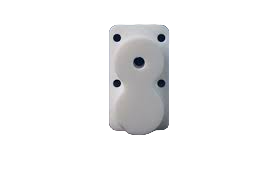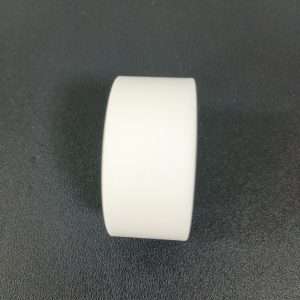Teflon Machining
All uploads are secure and confidential.
High chemical inertness, thermal stability, electrical insulation, and corrosion resistance. Teflon is a low-friction substance perfect for making non-sticky and sliding parts for various industries.
PTFE (Teflon) At a Glance
| Process compatibility | Applications | Tolerances | Wall Thickness | Max Part Size | Strengths | Lead Time | Price |
| CNC Mill CNC Lathe | Accurate parts for high-temperature electrical appliances. | Not lower than ±0.25 mm (±0.010″), based on the drawing ( ISO 2768) | Minimum 0.03″ (0.80 mm), but this can change depending on the proportion of the wall thickness to the linear dimension. | 200 x 80 x 100 cm | Good Mechanical strength, low friction coefficient, high Thermal strength, electrical insulation, and corrosion resistance. | Minimum 3 days. Not more than 10 days; for all complex parts. | $$ |
Introduction to PTFE (Telfon)
PTFE (Teflon) is one of the most slippery engineering thermoplastics with a low coefficient of friction and high thermal stability. Teflon is made with a combination of fluoropolymer, carbon, and fluorine atoms. It offers a range of beneficial properties such as high corrosion resistance, chemical stability, insulation resistance, and low dielectric constant.
It is an excellent choice for fabricating parts where friction occurs repeatedly and has a high operating temperature range. Teflon’s non-stick qualities made it the perfect material to cover cooking appliances. Additionally, it can be used in chemical, oil & gas, medical, and many other industries.
Expert Solutions in PTFE (Teflon) CNC Machining Services
PTFE (Polytetrafluoroethylene) is known for its exceptional chemical resistance and high melting point, which poses unique challenges in CNC machining. Its softness and tendency to deform require specialized machining techniques. Despite these challenges, PTFE’s machinability allows for the creation of precise and intricate parts, making it a sought-after material in various industries.
In the specialized field of PTFE (Teflon) CNC Machining Services, the role of expertise is paramount. The unique properties of PTFE, notably its non-stick and heat-resistant qualities, necessitate a deep understanding and specialized approach to machining. Therefore, Expert Teflon Machining Solutions are critical to achieving the precision required for quality components.
Furthermore, this expertise becomes particularly crucial in Precision CNC Machining for PTFE (Teflon) Parts, where the accuracy directly impacts the performance and reliability of the finished product.
The benefits of PTFE CNC machining services are manifold. PTFE parts exhibit excellent thermal resistance, non-stick properties, and minimal friction, making them ideal for chemical processing, electronics, and food applications. The Custom Teflon Parts Manufacturing involves tailored solutions that cater to the specific needs of various applications, from medical devices to aerospace components. Its ability to produce bespoke Teflon parts is essential for meeting the diverse requirements of these industries. Additionally, the CNC Machining of Teflon Materials demands a set of specific techniques and considerations. These include choosing the right cutting tools, adjusting machining parameters, and understanding the material’s behavior during the machining process to ensure optimal results.
- Handling Unique Material Properties: Navigating PTFE’s non-stick and heat-resistant nature to ensure flawless machining.
- Precision in Machining: Employing advanced techniques to achieve the high precision necessary for PTFE parts.
- Custom Manufacturing: Producing bespoke Teflon components tailored to specific application requirements.
- Technical Expertise: Leveraging specialized knowledge and experience in Teflon machining.
- Quality Assurance: Ensuring the highest standards of quality in every machined PTFE component.
- Diverse Industrial Applications: Adapting machining processes to cater to various industries relying on PTFE parts.
Our services are tailored to produce high-quality, precision-engineered PTFE parts that meet the specific needs of diverse industries. With Prolean, clients can expect exceptional quality and precision in every PTFE component we manufacture.
Expertise, Quality, and Affordability in PTFE CNC Machining

Our approach to PTFE CNC Machining Solutions at Prolean is holistic, focusing on delivering efficient and effective services.
1. Enhancing Efficiency in PTFE (Teflon) CNC Machining
The efficiency of PTFE (Teflon) CNC Machining is paramount to deliver top-quality components within stringent timelines. We employ Fast PTFE (Teflon) CNC Machining Services by recognizing the unique challenges presented by PTFE’s properties.
Our engineers and mechanists understand the importance of rapid response times in client communications. Thus, we have implemented the Instant Quotes for PTFE CNC Machining Services to enhance transparency, allowing clients to receive quick and accurate estimations of their projects.
2. Instant Quotes for PTFE CNC Machining
Prolean’s Online Quote for PTFE (Teflon) CNC Machining Service reflects our commitment to accessibility and convenience. Through user-friendly digital platforms, clients can effortlessly obtain service estimations, simplifying decision-making.
Our approach to PTFE machining is a blend of speed, accuracy, and client-centric services. With the integration of fast machining services and instant online quoting, Prolean continues to set industry standards in efficiency and customer satisfaction in the PTFE (Teflon) CNC Machining domain.
Comprehensive and Cost-Effective Teflon Machining Solutions
In the competitive terrain of CNC machining, Prolean sets itself apart by offering Comprehensive and Cost-effective PTFE CNC Machining Solutions. We effectively manage the PTFE CNC Machining Cost by optimizing machining processes and resource utilization. However, the lower cost does not sacrifice precision and quality.
- Quality Assurance Commitment: Our unwavering commitment to Quality Assurance in PTFE CNC Machining ensures all components meet rigorous standards.
- Dedication to Excellence: Every component is machined to excellence, demonstrating the high quality of its services.
- Expertise in Industrial Applications: Proficiency in Teflon CNC Machining for Industrial Applications, showcasing the ability to adapt and customize techniques for diverse industry needs.
- Tailored Machining Solutions: Prolean designs machining solutions specifically tailored to sectors like aerospace, medical, and automotive.
- Comprehensive and Cost-Effective: Our approach encapsulates Comprehensive and Cost-effective Teflon Machining Solutions, balancing quality with efficiency and affordability.



